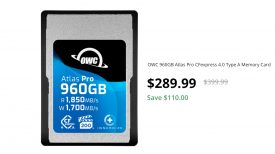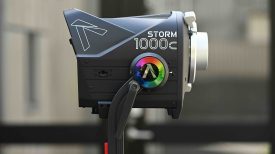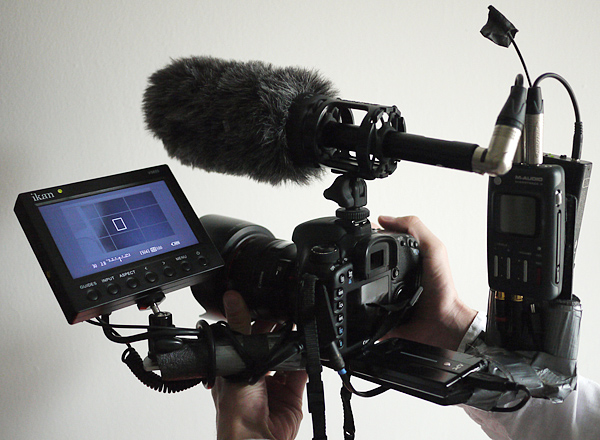
Recently, a couple people have asked me about my (and these are not my words) ghetto fabulous or franken-camera Canon Eos 7D video system. In some ways, the DSLR system for me simply represents a better camera, not a fundamental shift in video storytelling. Over the years, I’ve changed cameras when technology changed and quality got better but my style has more-or-less remained constant.
The biggest reason I had for not adopting DSLRs sooner was ergonomics. I could deal with the lack of timecode, the audio fixes and the overheating, but I simply couldn’t handhold the thing steady and interact with my characters at the same time. I wanted a DSLR built like the Sony Z1U, which I used lovingly for years. I checked out all the standard “rigs”, the Zacuto and the Redrockmicro, but they seemed to push me towards holding the camera like a Betacam, not cradling it like a baby or a football as is my practice.
In the end, I ended up saving money and getting a kit I could deal with. A $8 bracket (it’s literally the cheapest flash bracket that B&H stocks) holds the Ikan V5600 monitor out in front to the left of the lens just like the Sony Z1U. I splurged on another bracket (it was a hundred bucks), which holds the audio gear and balances the camera out by moving weight to the back of the camera.
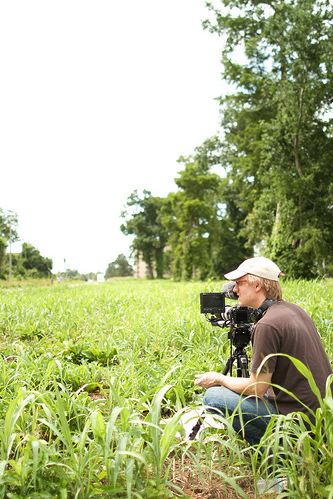
When setting up a DSLR rig, it always seems to be two steps forward and one step back. I was concerned about weight so I opted for the M-Audio Microtrack audio recorder instead of the other options with XLR inputs. (I had long ago abandoned trying to deal with the camera’s audio) But the battery on the Microtrack sucks, so I had to use a separate USB battery to charge the thing when its non-replaceable battery dies in the middle of the day. Still, the weight of both units is still considerably less than the other options.
With the ergonomics worked out, one of the first assignments I had was a series of stories with NPR’s Adam Davidson in Haiti for PBS/FRONTLINE. As soon as I headed out in the hot Haitian sun I was confronted with new issues to work out. The biggest surprise was the overheating. I had worked with a 5DmkII in the Chihuahuan desert in July, so I thought I was prepared, but in Haiti the 7D would shut down sometimes after only 30 minutes of shooting in the heat of the day. I quickly changed the way I work in order to minimize this DSLR flaw.
The other big headache was one I expected. My plan was to sync the audio at the end of each day of shooting. I used Pluraleyes and it worked about 90 percent of the time. Great, but that other 10 percent had a detrimental effect on my sleep during the 12 days I was in Haiti. After I had synced the audio, I exported the whole day’s shoot into one file in XDCAM422 30p format (This is a standard at FRONTLINE and we chose the format so it would more easily integrate with their Avid systems). That exported file became, for all practical purposes, my raw file. I imported into a new project to edit the piece. I also sent these files to FRONTLINE for them to prep the films for television broadcast.
Solving the Tap Tap Puzzle from Travis Fox on Vimeo.
Since the Haitian trip, the newest headache is keeping pace of changes to the DSLR system. Manual audio controls on the 5DmkII has made me question my decision to go with the 7D and makes me wonder if a similar audio fix will come to the 7D or if I should switch back to the 5DmkII. And with the release of Avid 5, the technical folks at FRONTLINE report that they will soon be able to deal with native 5DmkII/7D files, which will (thank god!) save me tons of time converting everything to other formats.
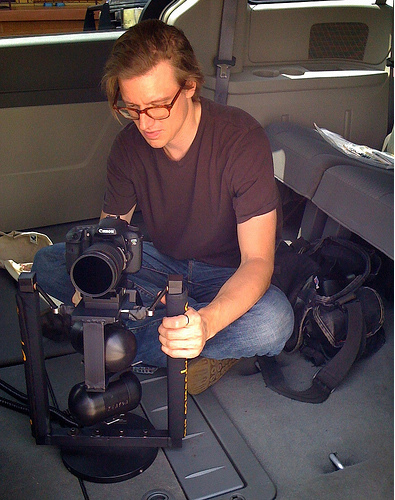
For more info in Travis and his work head over to his new blog http://blog.travisfox.com/






